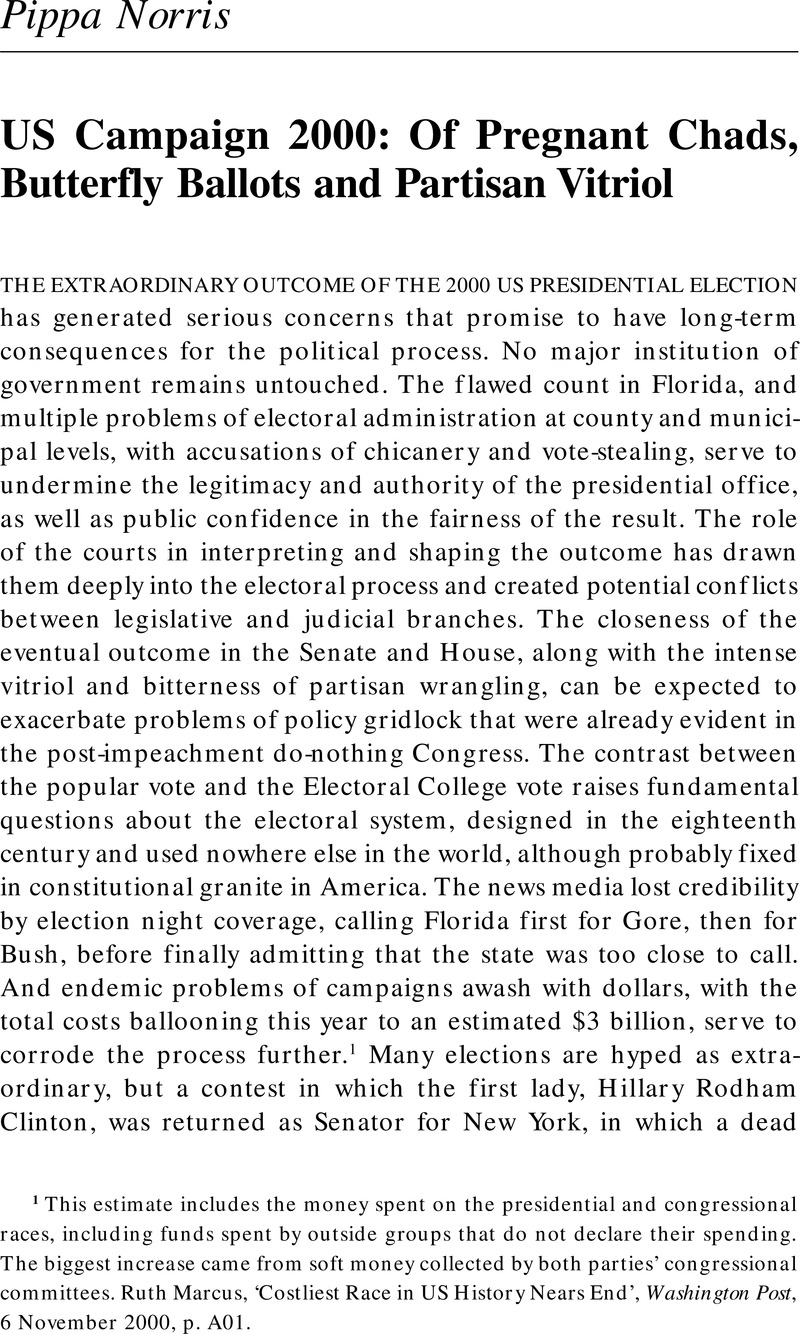Published online by Cambridge University Press: 28 March 2014

1 This estimate includes the money spent on the presidential and congressional races, including funds spent by outside groups that do not declare their spending. The biggest increase came from soft money collected by both parties’ congressional committees. Marcus, Ruth, ‘Costliest Race in US History Nears End’, Washington Post, 6 11 2000, p. A01 Google Scholar.
2 Governor Mel Carnahan died in a plane crash on 16 October yet he remained on the ballot and won the Missouri US Senate race.
3 For a balanced assessment of the President’s policy performance see Campbell, Colin and Rockman, Bert A (eds), The Clinton Legacy, New York, Chatham House Publishers/Seven Bridges Press, 2000 Google Scholar.
4 For a review of the forecasts see Kaiser, Robert, ‘Is This Any Way to Pick a Winner?’, Washington Post, PA01 Google Scholar. The estimates made at the September annual meeting, 26 May 2000, of the American Political Science Association were 52.8% ( James Campbell, University of Buffalo), 52.9% (Brad Lockerbie, University of Georgia), 53.2% (Alan Abramowitz Emory University), 55% (Helmut Norpoth, SUNY), 55.2% (Christopher Wlezian, University of Houston) and 60.3% (Thomas Holbrook, University of Wisconsin). In mid-October Michael Lewis-Beck and Charles Tien forecast that, based on presidential popularity, the percentage change in GNP, and a peace and prosperity index, Al Gore would get 55.4% of the popular vote, and that the Democrats would regain the House and the Senate. http://Urban.hunter.cuny.edu/~ctien/ For a critical review of the economic models and replies see Eisenhower, Karl and Nelson, Pete, ‘The Phony Science of Predicting Elections’, Slate, 20 05 2000. http://slate.msn/com/Features/forecast.forecast.asp Google Scholar
5 For details see Joint Economic Committee and the Council for Economic Advisers, Economic Indicators, US Government Printing Office, Washington DC, 2000 Google Scholar.
6 See, for example, US Department of Commerce, The Emerging Digital Economy, US Department of Commerce, Washington DC, 1999 Google Scholar. http:www.ecommerce.gov/ede.
7 Woodward, Bob, Maestro: Greenspan’s Fed and the American Boom, New York, 2000 Google Scholar.
8 The Gallup Organization, Princeton. Polls from 14–15 September 1999 to 6–9 October 2000. www.gallup.com/poll
9 For an assessment of Clinton’s foreign policy see Berman, Emily O Goldman, and Larry, ‘Engaging the World: First Impressions of the Clinton Foreign Policy Legacy’, in Campbell, Colin and Rockman, Bert A. (eds), The Clinton Legacy, New York, Chatham House Publishers/Seven Bridges Press, 2000 Google Scholar.
10 The Gallup Organization, Princeton, Polls from September 14–15 1999 to October 6–9 2000. www.gallup.com/poll
11 The Voter News Service exit poll was conducted by questionnaires completed by 13,279 voters leaving 300 polling places around the nation on election day. For details see www.cnn.com/ELECTION/2000/wpolls/US/P000.html
12 It should be noted that only 1% disapproved of Clinton’s performance but liked the man.
13 The Gallup Organization, Princeton, Overall Presidential Approval Ratings 1953– 1999, www.gallup.com/poll/trends/ptjobapp.asp
14 For previous declarations see Harold W, Stanley and Niemi, Richard G, Vital Statistics on American Politics 1999–2000, Washington DC, CQ Press, 2000, Figure 1.4 pp. 63–4Google Scholar.
15 The Pew Research Center for the People and the Press, ‘Much Less Convention Interest’, Survey July 27 2000, www.people-press.org Google Scholar
16 Nielsen Media Research. www.Nielsenmedia.com
17 The audience on all TV channels was estimated to be over 60 million for each debate in 1992 and 1996, and declined to between 35–45 million in 1996 and 2000. For details see www.nielsenmedia.com.
18 For details see the Hess Report, Brookings Institution and the Center for Media and Public Affairs. http://www.brookings.edu/GS/Projects/HessReport
19 ‘Campaign 2000 highly rated’ based on a poll conducted 10–12 November 2000 by the Pew Research Center for the People and the Press. See www.people-press.org
20 For more details see Norris, Pippa, ‘Too Close to Call: Opinion Polls in Campaign 2000’, The Harvard International Journal of Press-Politics, 6:1 (2000)Google Scholar.
21 ‘Pregnant chads’ are the ballot papers that have been slightly indented by voting styluses, rather than wholly pushed through.
22 ‘Butterf ly ballots’ refers to the designs used in Miami Dade county, with the names of candidates listed on both sides of the ballot paper, where many ex-New York Jewish retirees (i.e. snowbirds) were confused into voting for Buchanan rather than Gore.